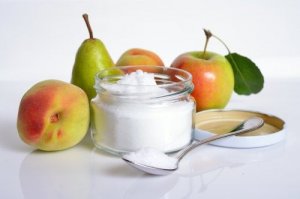Diet for Hereditary Fructose Intolerance and Fructose Malabsorption

Many people with fructose intolerance are uncertain about the foods they should and shouldn’t eat. To resolve this problem, first of all, it’s important to know about the component that causes the intolerance, what foods contain it, and what specific condition the person suffers from.
However, there are many diets for people with fructose intolerance. Thus, when they are clear about the above points, they’ll have no problem following a proper diet.
What’s fructose?

Fructose is a simple sugar that’s naturally found in fruits. Normally, it’s ingested as sucrose. This substance is no more and no less than the table sugar we all know and love. When you consume sucrose, it divides into its components in the intestines, releasing glucose and fructose.
It’s also important to know that sorbitol is another source of fructose. This substance is a sweetener, which, when metabolized by the body, can generate fructose.
Furthermore, fructose, under normal conditions, has to be absorbed by your intestinal cells and metabolized in your body so that you can take advantage of its properties. A person suffers from fructose intolerance when their bodies have problems both absorbing and metabolizing this simple sugar.
In order to know the proper diet for people with fructose intolerance, it’s essential to distinguish between hereditary fructose intolerance and fructose malabsorption.
You may also want to read: Everything You Need to Know About Lactose Intolerance
Hereditary fructose intolerance
The cause of this disease is a genetic mutation that affects fructose metabolization. It occurs in 1 in 20,000 people. This mutation causes these individuals to lack the enzyme involved in the body’s biochemical reactions: fructose-bisphosphate aldolase B or aldolase B.
When a person lacks this enzyme, which is responsible for metabolizing fructose, this sugar accumulates in the form of an intermediate product of the conversion of fructose, which is toxic.
Fructose malabsorption

This is a digestive disorder that impairs the absorption of fructose. It affects about 30% of the population. Patients with this condition have cells in their intestines that are unable to absorb fructose. Thus, gastrointestinal symptoms occur.
The diet you have to follow will depend on the pathology that you suffer from.
Diet for people with hereditary fructose intolerance
People with this type of fructose intolerance must follow a strict diet. They can’t consume more than one to two grams of this sugar.
Therefore, it’s important for the patient to read all food labels to ensure they’re fructose-free. Unfortunately, people who suffer from this disorder can’t consume most manufactured foods.
To get an inkling of the foods that people with hereditary fructose intolerance can and can’t consume, read the following list:
Allowed foods
- Sweeteners. Glucose syrup, saccharin, cyclamate.
- Fruits (only occasionally). Avocado, ripe olives.
- Vegetables. Chard, broccoli, spinach, potatoes, mushrooms, endives.
- Vegetables of limited consumption. Celery, watercress, cabbage, cucumber, lettuce, cauliflower.
- Meat and fish. Fresh only.
- Cereals and their by-products. Wheat flour, oats, corn, rye, white bread, rice.
People with this disorder can’t consume processed meats or fish that contain fructose, sucrose, or sorbitol. Also, they can’t consume soy drinks, condensed milk, fruit yogurt, or tomatoes, among other foods.
You should also read: Health Benefits of Consuming Less Sugar
Diet for people with fructose malabsorption

To prevent the development of gastrointestinal symptoms, patients with fructose malabsorption should reduce their fructose consumption, either totally or partially.
Thus, they should follow fructose-restricted diets. This restriction will vary, depending on whether they suffer from total or partial malabsorption and the degree of their intolerance.
If the patient suffers from total malabsorption, their diet should be similar to the one people with hereditary fructose intolerance follow. In other words, they should avoid eating foods that contain fructose or sucrose.
On the other hand, people with partial malabsorption, which is the most common pathology, can consume foods low in sugar. They can even consume a moderate amount of foods high in fructose.
Here are some foods high in fructose:
- Dried apricots, persimmons, and cherries.
- Prunes and custard apples.
- Apples, pears, and grapes.
Conversely, here are some of the foods low in fructose:
- Papayas, avocado, coconut, and groundnuts.
- Hazelnuts and chestnuts.
- Artichokes, eggplants, chard, and mushrooms.
- Milk, cheese, and eggs.
- Fresh meat and fish.
Despite all these indications, it’s important to seek specialist advice if you suffer from any of these conditions so they can help you decide on a personalized diet based on your individual needs.
All cited sources were thoroughly reviewed by our team to ensure their quality, reliability, currency, and validity. The bibliography of this article was considered reliable and of academic or scientific accuracy.
- Buzas GM., Fructose and fructose intolerance. Orv Hetil, 2016. 157 (43): 1708-1716.
- Hannou SA., Haslam DE., McKeown N., Herman MA., Fructose metabolism and metabolic disease. J Clin Invest, 2018. 128 (2): 545-555.
- Baker P., Ayres L., Gaughan S., Weisfeld Adams J., et al., Hereditary fructose intolerance, 2015.
This text is provided for informational purposes only and does not replace consultation with a professional. If in doubt, consult your specialist.








